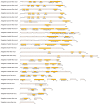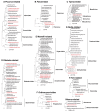Virome Analysis Reveals Diverse and Divergent RNA Viruses in Wild Insect Pollinators in Beijing, China
- PMID: 35215821
- PMCID: PMC8877953
- DOI: 10.3390/v14020227
Virome Analysis Reveals Diverse and Divergent RNA Viruses in Wild Insect Pollinators in Beijing, China
Abstract
Insect pollinators provide major pollination services for wild plants and crops. Honeybee viruses can cause serious damage to honeybee colonies. However, viruses of other wild pollinating insects have yet to be fully explored. In the present study, we used RNA sequencing to investigate the viral diversity of 50 species of wild pollinating insects. A total of 3 pathogenic honeybee viruses, 8 previously reported viruses, and 26 novel viruses were identified in sequenced samples. Among these, 7 novel viruses were shown to be closely related to honeybee pathogenic viruses, and 4 were determined to have potential pathogenicity for their hosts. The viruses detected in wild insect pollinators were mainly from the order Picornavirales and the families Orthomyxoviridae, Sinhaliviridae, Rhabdoviridae, and Flaviviridae. Our study expanded the species range of known insect pollinator viruses, contributing to future efforts to protect economic honeybees and wild pollinating insects.
Keywords: honeybees; next-generation sequencing; novel RNA viruses; viral diversity; wild insect pollinators.
Conflict of interest statement
The authors declare no conflict of interest.
Figures



Similar articles
-
Divergence and convergence of gut microbiomes of wild insect pollinators.mBio. 2023 Aug 31;14(4):e0127023. doi: 10.1128/mbio.01270-23. Epub 2023 Jul 28. mBio. 2023. PMID: 37504575 Free PMC article.
-
The Insect Virome: Opportunities and Challenges.Curr Issues Mol Biol. 2020;34:1-12. doi: 10.21775/cimb.034.001. Epub 2019 Jun 6. Curr Issues Mol Biol. 2020. PMID: 31167953 Review.
-
A sting in the spit: widespread cross-infection of multiple RNA viruses across wild and managed bees.J Anim Ecol. 2015 May;84(3):615-624. doi: 10.1111/1365-2656.12345. Epub 2015 Mar 3. J Anim Ecol. 2015. PMID: 25646973 Free PMC article.
-
Mining Public Data to Investigate the Virome of Neglected Pollinators and Other Floral Visitors.Viruses. 2023 Aug 31;15(9):1850. doi: 10.3390/v15091850. Viruses. 2023. PMID: 37766257 Free PMC article.
-
Viruses of commercialized insect pollinators.J Invertebr Pathol. 2017 Jul;147:51-59. doi: 10.1016/j.jip.2016.07.010. Epub 2016 Aug 3. J Invertebr Pathol. 2017. PMID: 27498219 Review.
Cited by
-
Virome Analysis of Normal and Growth Retardation Disease-Affected Macrobrachium rosenbergii.Microbiol Spectr. 2022 Dec 21;10(6):e0146222. doi: 10.1128/spectrum.01462-22. Epub 2022 Nov 29. Microbiol Spectr. 2022. PMID: 36445118 Free PMC article.
-
Characterisation of the virome of Culicoides brevitarsis Kieffer (Diptera: Ceratopogonidae), a vector of bluetongue virus in Australia.J Gen Virol. 2025 Feb;106(2):002076. doi: 10.1099/jgv.0.002076. J Gen Virol. 2025. PMID: 39976626 Free PMC article.
-
Black queen cell virus detected in Canadian mosquitoes.J Insect Sci. 2023 Mar 1;23(2):10. doi: 10.1093/jisesa/iead016. J Insect Sci. 2023. PMID: 37004145 Free PMC article.
-
Annual (2023) taxonomic update of RNA-directed RNA polymerase-encoding negative-sense RNA viruses (realm Riboviria: kingdom Orthornavirae: phylum Negarnaviricota).J Gen Virol. 2023 Aug;104(8):001864. doi: 10.1099/jgv.0.001864. J Gen Virol. 2023. PMID: 37622664 Free PMC article.
-
The Viromes of Six Ecosystem Service Provider Parasitoid Wasps.Viruses. 2023 Dec 16;15(12):2448. doi: 10.3390/v15122448. Viruses. 2023. PMID: 38140687 Free PMC article.
References
-
- Ollerton J., Winfree R., Tarrant S. How many flowering plants are pollinated by animals? Oikos. 2011;120:321–326. doi: 10.1111/j.1600-0706.2010.18644.x. - DOI
-
- Garibaldi L.A., Steffan-Dewenter I., Winfree R., Aizen M.A., Bommarco R., Cunningham S.A., Kremen C., Carvalheiro L.G., Harder L.D., Afik O., et al. Wild pollinators enhance fruit set of crops regardless of honey bee abundance. Science. 2013;339:1608–1611. doi: 10.1126/science.1230200. - DOI - PubMed
Publication types
MeSH terms
LinkOut - more resources
Full Text Sources

